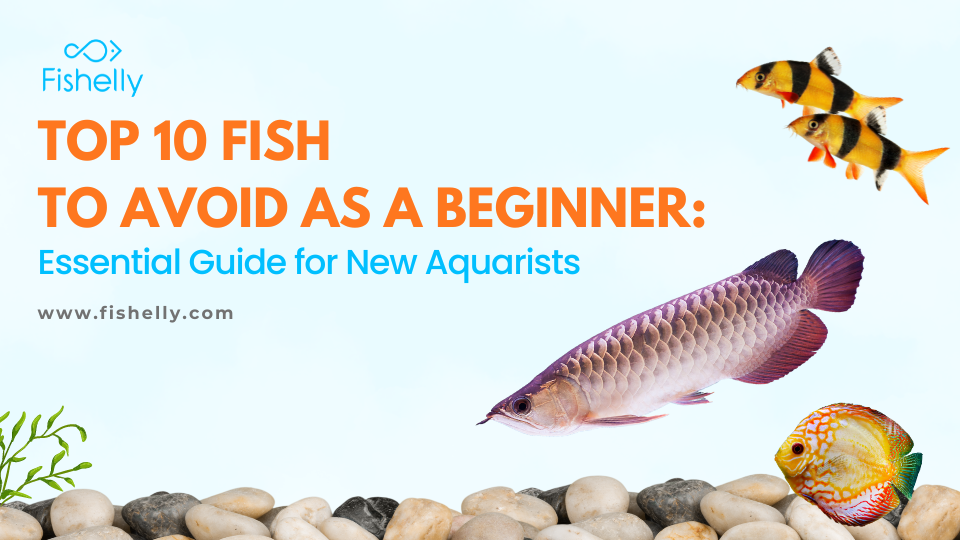Top 10 Fish to Avoid as a Beginner: Essential Guide for New Aquarists
The process of starting your own aquarium may be a thrilling and rewarding experience, however for novices, it's essential to select the appropriate species of fish to ensure the best beginning. Certain fish even though they are beautiful and attractiveness, require more advanced maintenance and are not recommended for people who are new to the hobby. In this article we'll examine some of the most popular fish for beginners should stay clear of, with reasons for why they may pose a challenge to novice aquarists.
1. Discus Fish (Symphysodon)
Overview:
Discus fish are known for their striking colors and elegant shape, making them highly desirable in the aquarium community. However, they are also one of the most challenging species to care for, especially for beginners.
Why to Avoid:
Discus fish are extremely sensitive to water quality, requiring very specific conditions including a stable pH, warm temperatures (82-86°F), and pristine water. They are also prone to stress and need a well-established, mature tank with a lot of space. Feeding them can also be difficult as they prefer a varied diet and are picky eaters.
2. Mandarin Dragonet (Synchiropus splendidus)
Overview:
The Mandarin Dragonet is a small, brightly colored fish that is highly sought after for its unique appearance. Despite its beauty, it’s not recommended for beginners.
Why to Avoid:
Mandarin Dragonets have very specific dietary needs, primarily feeding on live copepods that are difficult to provide in a beginner’s tank. They require a well-established aquarium with a large, thriving population of live food. Additionally, they are slow eaters and often struggle to compete for food in a community tank.
3. Moorish Idol (Zanclus cornutus)
Overview:
Moorish Idols are one of the most iconic and visually stunning marine fish, often recognized by their long, trailing dorsal fin and bold black, white, and yellow stripes.
Why to Avoid:
Moorish Idols are notoriously difficult to keep in captivity due to their very specific dietary requirements and sensitivity to water conditions. They are often reluctant to eat prepared foods and may starve in an aquarium. Moreover, they require a very large tank with excellent water quality and plenty of swimming space, making them unsuitable for most beginners.
4. Clown Loach (Chromobotia macracanthus)
Overview:
Clown Loaches are popular freshwater fish known for their playful behavior and distinctive black-and-orange striped bodies.
Why to Avoid:
Clown Loaches grow very large—up to 12 inches in length. It means they require a very large tank, typically 100 gallons or more. They are also social fish that need to be kept in groups, further increasing the space requirements. Additionally, they are prone to ich (a common fish disease) and need stable water conditions, making them challenging for beginners.
5. Flowerhorn (Cichlasoma)
Overview:
Flowerhorns are hybrid cichlids known for their vibrant colors, distinctive nuchal hump (the pronounced bump on their heads), and unique patterns. These striking fish are highly sought after for their bold appearance and lively personalities.
Why to Avoid:
Flowerhorns are not recommended for beginners due to their aggressive nature and demanding care requirements. They are highly territorial and can be very aggressive towards other fish, making them difficult to keep in a community tank. Flowerhorns also grow large, often reaching up to 12-16 inches, and require a spacious tank of at least 75 gallons. Their strong personality and high intelligence mean they need plenty of mental stimulation and a carefully maintained environment to thrive. The high bioload they produce demands rigorous filtration and regular water changes to keep water quality pristine, which can be challenging for novice aquarists.
6. Arowana (Osteoglossum bicirrhosum)
Overview:
Arowanas are majestic, elongated fish that are often regarded as symbols of luck and prosperity in many cultures. Their sleek bodies, large scales, and graceful swimming style make them a captivating addition to large aquariums.
Why to Avoid:
Arowanas are considered one of the most challenging fish to care for, making them unsuitable for beginners. They are predatory fish that can grow up to 3 feet in length, requiring an extremely large tank (at least 250 gallons) with a secure lid. Moreover Arowana fish are popular for their ability to jump out of the water. Arowanas are also solitary and can become highly aggressive towards other tank mates. Their diet consists mainly of live food, such as insects and small fish, which can be difficult to manage and maintain. Additionally, they require very specific water conditions, including soft, slightly acidic water, and excellent filtration to handle their high waste output.
7. Ghost Knife Fish (Apteronotus albifrons)
Overview:
The Ghost Knife Fish, known for its sleek, black body and undulating motion, is an enigmatic species that captures the interest of many aquarists. Its unique appearance and nocturnal behavior make it a fascinating but challenging addition to an aquarium.
Why to Avoid:
Ghost Knife Fish are not ideal for beginners due to their specialized care requirements and shy, nocturnal nature. They can grow up to 20 inches in length, necessitating a large tank of at least 100 gallons with plenty of hiding spots and subdued lighting to mimic their natural habitat. Ghost Knife Fish are also sensitive to water quality and require stable, well-maintained water parameters. Their diet can be challenging as they prefer live or frozen foods like bloodworms and brine shrimp, rather than standard fish flakes or pellets. Additionally, they can be territorial, especially with other Ghost Knife Fish or similarly shaped species, making them difficult to house in a community setting.
8. Shubunkin Goldfish (Carassius auratus)
Overview:
Shubunkin Goldfish are a type of fancy goldfish known for their beautiful, calico-patterned scales and hardy nature. They are often kept in outdoor ponds or large aquariums due to their ability to thrive in cooler water temperatures.
Why to Avoid:
While Shubunkins are more resilient than some other fancy goldfish, they still present challenges for beginners. They can grow up to 12-14 inches in length, requiring a spacious tank of at least 30 gallons per fish, and even more room in a community setting. Like other goldfish, Shubunkins produce a significant amount of waste, which can quickly degrade water quality if not managed with a powerful filtration system and regular water changes. Additionally, they are best kept in cooler water temperatures, which may require a different setup than most tropical fish tanks. Their active swimming behavior and need for space also mean that they are not well-suited to small or overcrowded tanks.
9. Plecostomus (Common Pleco)
Overview:
Common Plecos are often sold as algae eaters, but their size and care requirements make them unsuitable for most beginners.
Why to Avoid:
Common Plecos can grow up to 24 inches in length, requiring a tank of at least 100 gallons. They are also known for producing a significant amount of waste, which can compromise water quality if not managed properly. Their large size and waste production can quickly overwhelm a beginner’s tank, leading to poor conditions for all inhabitants.
10. Fancy Goldfish (Carassius auratus)
Overview:
Fancy Goldfish are popular for their vibrant colors and unique body shapes, but they are not as easy to care for as their hardier cousins, the common goldfish.
Why to Avoid:
Fancy Goldfish are prone to swim bladder issues due to their rounded body shape, which can cause buoyancy problems. They also require a large, well-filtered tank as they produce a lot of waste. Additionally, they need cooler water temperatures compared to most tropical fish, which can be difficult to maintain in a typical community tank setup.
Conclusion
While these fish are beautiful and intriguing, they require a level of care and experience that can be challenging for beginners. As you start your journey into the world of fishkeeping, it’s important to choose species that are more forgiving and easier to manage.
Consider starting with hardy species such as guppies, mollies, or bettas, which are well-suited to beginners and will help you gain the necessary experience to care for more demanding fish in the future. Remember, successful fishkeeping starts with choosing the right fish for your skill level and providing them with the proper environment to thrive.















